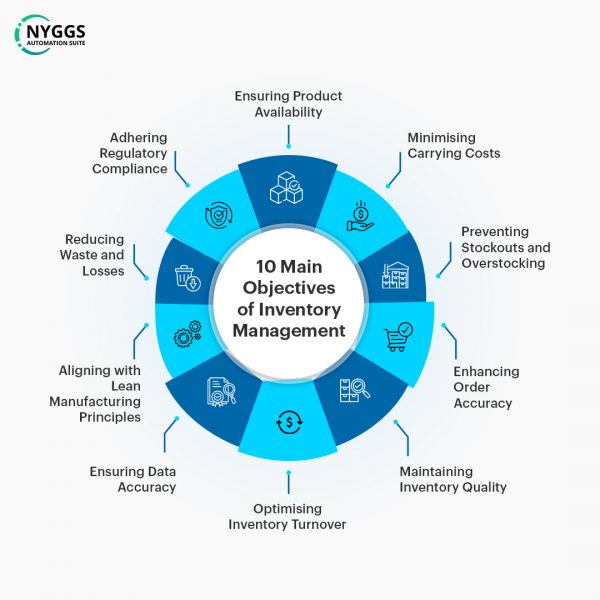No matter if there is a tiny shop or a massive company, inventory management is essential for the smooth running of a business.
Table of Contents
ToggleIn fact, it lays the groundwork for effective supply chain operations that directly affect the company’s profit.
But what exactly are the objectives of inventory management? Why is it so influential for companies to get it right?
These are the questions we want to answer in this blog. We also aim to provide a comprehensive understanding of its importance and some practical methods for achieving these objectives. Let us start!
10 Main Objectives of Inventory Management
If you are a business owner, supply chain manager, or inventory specialist, knowing these ten objectives of inventory control can help you transform your business.

1. Ensuring Product Availability and Meeting Customer Demand
Product availability should be the primary inventory management’s main goal.
34% of businesses have had an order ship late because they mistakenly sold a product that was out of stock. The result? Unhappy customers and loss of sales.
So, having full visibility of the right products, in the right quantities, at the right time helps you meet customers’ demands. It results in improved brand reputation and customer loyalty.
Take inventory management software, for example. This tool allows you to achieve effective inventory management by involving:
- Accurate demand forecasting,
- Timely alerts on inventory fulfilment,
- Avoiding overstocking that ties up capital and
- Preventing out-of-stocks that lead to lost sales.
Consequently, the software helps maintain a balance between inventory and customer demand.
2. Minimising Carrying Costs and Reducing Excess Inventory
Of all the objectives of inventory management, minimising carrying costs is the most important to inventory specialists. These are the costs connected with holding inventory including storage, insurance, and depreciation.
Ideally, you should not spend more than 20–30% of your total inventory value on carrying costs. The exact percentage may vary by industry and business size, but it is important to keep an eye on unsold inventory.
Moreover, reducing excess inventory directly lowers these costs by freeing up capital and valuable warehouse space, which can be used for other business activities. Plus, the longer you hold on to your stock, the greater the risk of obsolescence, damage, or even theft!
So, effective inventory management strategies, such as a just-in-time (JIT), can help in achieving this objective. JIT is all about ordering exactly what you need and when you need it to meet current demand.
Remember, keeping your carrying costs low and your inventory lean is key to a financially healthy business. In summary, it is about making smart choices—when to order and how much—to maintain those perfect inventory levels.
3. Preventing Stockouts and Overstocking
Preventing stockouts and overstocking is critical to inventory management.
Why?
- Firstly, stockouts (unavailable items) can lead to lost sales, customer dissatisfaction, and damage to a company’s reputation.
- Secondly, overstocking results in excess inventory. As discussed earlier, this can lead to increased carrying costs and the risk of outdated/old inventory.
Inventory management systems can help prevent both of these scenarios. They do this by providing real-time data on inventory levels and using forecasting tools to predict future demand. It is true to maintain the right stock level, avoiding both stockouts and overstocking.
4. Enhancing Order Accuracy and Customer Satisfaction
Ensuring order accuracy and customer satisfaction have become more pivotal objectives of inventory management.
According to a recent survey, 58% of consumers say they’d stop buying from a brand entirely after one to three supply chain delays or disruptions. This demonstrates the importance of timely delivery for maintaining customer loyalty and brand reputation.
But the question is: How do you know if you are ordering the right amount?
Use inventory management systems. These systems play a crucial role in enhancing order accuracy by allowing you to:
- Track inventory levels in real-time.
- Accurate visibility into the availability of the right products.
- View the trend of product demand in a particular season through its demand forecasting feature.
Moreover, accurate order fulfilment can also lead to repeat business. Satisfied customers are more likely to return and make additional purchases. In short, it also helps in building long-term customer relationships and driving business growth.
5. Maintaining Inventory Quality and Product Reliability
Inventory quality is an essential feature of inventory management!
It involves ensuring that the products in stock are in good condition and meet the required standards. Additionally, this is a more critical aspect of products that have an expiration date, as the rules are getting stricter.
So, high-quality inventory contributes to product reliability, which is crucial for customer satisfaction and meeting regulations.
Here is how to maintain inventory quality with inventory management systems:
- Allow you to schedule regular checks.
- Send regular audit alerts to identify and remove damaged or expired items.
- Help you forecast demand to avoid overstocking and overordering for a season.
So, your primary goal is to ensure that only high-quality products reach customers. That reduces returns and refunds, saves money, and protects the company’s reputation.
6. Optimising Inventory Turnover and Cash Flow
Inventory turnover is a useful metric in inventory management because it shows how often a company sells and replaces its stock. You can calculate it using the inventory turnover ratio formula:
Inventory Turnover Ratio (ITR) = Cost of Goods Sold (COGS) / Average Inventory Value.
So, if your COGS for 2024 totalled INR 2,00,000 and your inventory was worth INR 40,000, your ITR would be 5.
A good inventory turnover ratio is between 5 and 10. This means you sell and restock your inventory every 1–2 months. In other words, this ratio is just right for having enough inventory without having to reorder too often. An important goal among the top objectives of inventory management, isn’t it?
7. Ensuring Data Accuracy with Real-Time Inventory Tracking
Calculating inventory accuracy is crucial because it provides a clear picture of up-to-the-minute information on inventory levels across all sales channels. This information is vital for avoiding stockouts and overstocking, and aiding demand forecasting.
You can calculate inventory accuracy with a simple formula = [counted items / items on record] * 100.
To make it simple:
To find your inventory accuracy, start by counting how many units of a specific stock-keeping unit (SKU) you have. Divide that number by the recorded stock count of that same SKU. Then multiply by 100.
Voila, you have your inventory accuracy expressed as a percentage. Generally, a good inventory accuracy rate sits around 97% or higher.
However, retrieving highly accurate data requires robust systems and processes. This includes the use of inventory management software, regular inventory audits, and staff training. Take advantage of the tool to learn about real-time inventory levels, sales trends, and customer demand.
8. Aligning Inventory Management with Lean Manufacturing Principles
Lean manufacturing principles mean eliminating all non-value-adding activities and waste from the business. These principles can be applied to inventory management to achieve similar objectives.
One of the essential lean principles is JIT production. This involves producing goods only as they are needed, reducing inventory levels, and carrying costs. But, you need accurate demand forecasting and efficient supply chain management to follow this principle.
Another lean principle is continuous improvement. This involves regularly reviewing and improving inventory management processes to reduce waste. It may include using inventory management software to automate processes and improve accuracy. This is one of the key objectives of inventory control that supports overall business performance.
9. Reducing Waste and Losses through Effective Inventory Control
Next, we will talk about inventory control. It is a critical aspect to look out for the good of our planet and ourselves. Its primary objective is to minimise waste and losses, which can occur due to spoilage, damage, or theft.
Regular audits and cycle counts can prove an effective method of inventory control. These ensure that the physical inventory matches the recorded inventory, helping to identify and rectify discrepancies.
You can use various techniques for inventory control, like:
- ABC analysis prioritises which items to order and store, allowing you to keep better track of stock level.
- Use the first-in, first-out (FIFO) method if you want to control perishable goods that can spoil quickly.
- The last-in, first-out (LIFO) method controls those stocks where the cost of inventory increases over time.
- The batch tracking method allows managers to better control a particular group of items with an expiration date.
- Minimum order quantity (MOQ) is the minimum amount of stock that should be ordered from a supplier at one time, enabling tight control over overall inventory.
These methods can help ensure proper storage conditions and handling procedures can reduce damage and spoilage, preserving the quality and value of the inventory.
10. Achieving Regulatory Compliance and Risk Management
Compliance and risk management are key to effective inventory management. They protect the company from legal issues, financial losses, and damage to its reputation.
Therefore, inventory management practices must ensure compliance with all relevant regulations.
Risk management is another primary objective of inventory management. It involves identifying and reducing risks to inventory, such as supply chain problems, market changes, and analysis of demand changes.
Conclusion
In summary, the objectives of inventory management are clear: to make stock available when needed.
However, its objectives can extend beyond simple stock control to cost reduction, customer satisfaction, risk management, and regulatory compliance.
Furthermore, the importance of inventory management software cannot be overstated. This tool plays a vital role in positively impacting a company’s bottom line and its ability to meet customer expectations.
Want to learn more about inventory management systems? Click on the button to schedule a demo!







